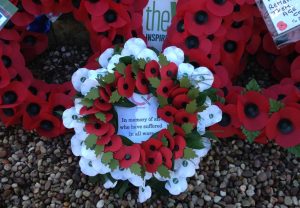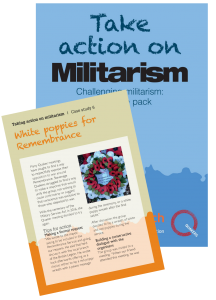Armistice Day was intended to mark a day of intense sadness and grief at the enormous cost of war and the failure of humanity to prevent it. But the nature of Remembrance in Britain has changed over recent years. The Remembrance period has become elaborate and lengthy and co-opted by military interests and promotional messages. Official Remembrance ceremonies have a narrow focus on British servicemen and women, with little recognition of the effects of war on service personnel and civilians from other parts of the world.
We all have a part to play in the public debate around Remembrance. Individual or community acts of rethinking the Remembrance message are vital to counter the inherent militarism of official ceremonies.
Poppy politics
Remembrance is a broad concept. While some emphasise the importance of saying ‘never again’ to loss and suffering, others see no reason to question the morality of the wars in which it happened. While the poppy can signify both these positions, the official act of memorialising war tends to glorify and sanitise it. The focus on honouring members of the armed forces can become blurred. Official messaging by the Royal British Legion, the military, the government and public authorities has increasingly included elements that emphasise demonstrating support the armed forces rather than reflecting on the suffering of war or acknowledging it as human failure.
A sense of obligation to demonstrate uncritical support for marking the day has developed. TV presenters and other public figures are instructed to wear a red poppy for many days before Armistice Day, sporting events in November are heavily branded with the poppy and some schools even require all their pupils to wear one.
Although a charity, the Royal British Legion has developed a style of operating that is reminiscent of a large corporation. It has commercialised Remembrance by heavily pushing the sale of red poppies and related merchandise and claims a legal ownership over the poppy brand. Some of its ventures – poppy-themed pop bands and jewellery – speak more of commercial logic than of sensitivity to the issue of war, death and killing.
Its fundraising through corporate partnerships should also raise major concerns. The Remembrance Centre at the National Memorial Arboretum is sponsored by arms companies, including BAE Systems and Boeing Defence UK (see the full list). Surely this has to be challenged?
The language used during Remembrance is euphemistic, glorifying and sanitising the consequences of warfare. Narratives around the nobility and sacrifice of fighting to protect our freedoms mask the reality of the causes and impact of war and create a sense of uncritical acceptance.
In recent years, there has been more public debate about the character of Remembrance as many people have grown uncomfortable with aspects of it. Many question the imbalance between the act of remembering and the focus on fundraising and promotion of the armed forces. White poppy sales are high as people seek to express their desire for peace through Remembrance.
Answering questions
Won’t talking about white poppies for peace show disrespect for the armed forces?
A white poppy signifies remembering all the victims of wars. It can be worn without showing any disrespect for individuals in the armed forces or offending those who may be mourning the loss of loved ones. Many veterans and others who have lost friends and family through conflict wear a white poppy.
What is wrong with honouring those who have suffered in war?
Remembrance ceremonies can sometimes reinforce the view that war is acceptable and natural, however regrettable it may be. While it is very important to remember all those who have suffered as a result, it is also important to question why it happens and not allow Remembrance to be used to sanction military action.
Why do you want to challenge the way Remembrance is held?
Remembrance ceremonies are not set in stone. They change over time to reflect the interests of the institutions that organise them. The military is currently concerned about public promotion of the armed forces and recruitment and Remembrance has become another opportunity for this. It is also an opportunity to raise funds, which can lead to tensions between the core message and maximizing income. The public debate around how we remember the causes and consequences of war is very important for future generations and it is vital that those who work for peace are part of that debate.
How can school students explore Remembrance?
Exploring Remembrance in schools is an opportunity to encourage critical thinking about the causes and consequences of war and to understand that this essential critique in no way dishonours or disrespects those who have suffered. Learning activities should look at warfare from different perspectives and avoid euphemistic language or ideas that glorify or sanitise warfare. Schools could also be encouraged to explore the meaning of the white poppy and non-militarised solutions to conflict that emphasis peacebuilding and long-term security.
The white poppy
The white poppy is a symbol of Remembrance. It explicitly says “No more wars. No more killing. Let us work for peace.” It was introduced by the Women’s Cooperative Guild in 1933. The white poppy represents those on all sides who have died, been injured or still suffer in conflicts across the world. Each year more and more people wear white poppies or lay a wreath of them at their local war memorial. Some choose a mix of red and white poppies. Some choose to wear neither. Many find a white poppy prompts conversation around war, peace, Remembrance and hope.


